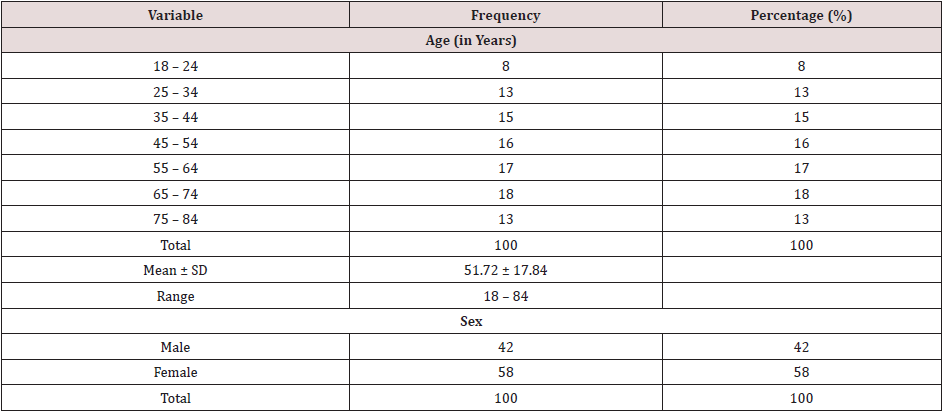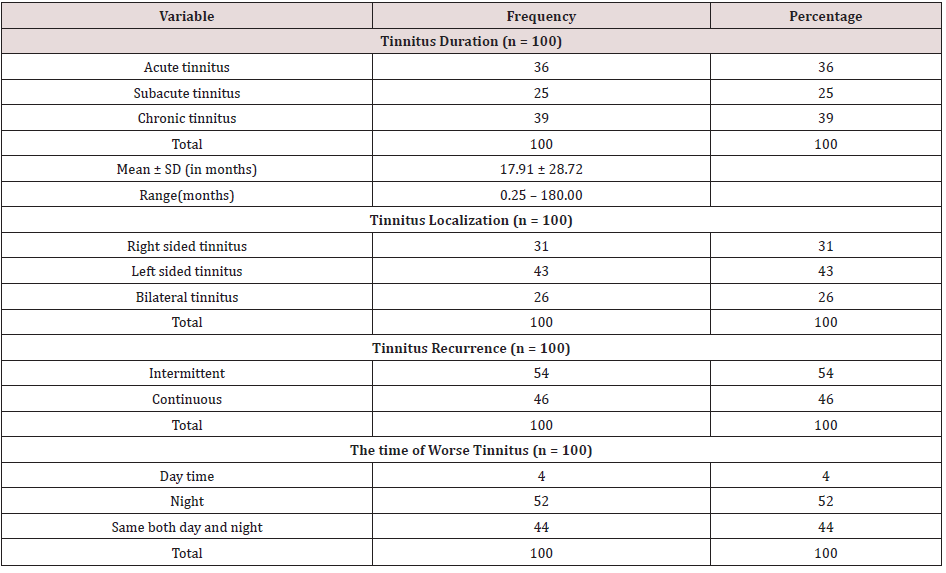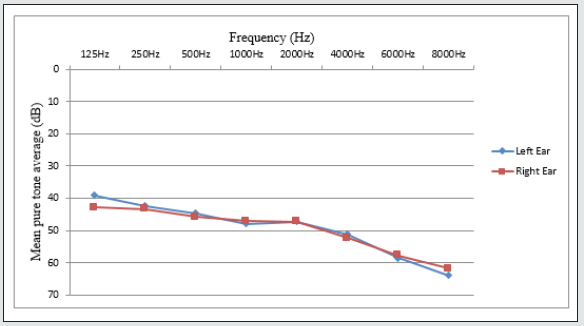
Lupine Publishers Group
Lupine Publishers
Menu
ISSN: 2641-1709
Research Article(ISSN: 2641-1709) 
Audiometric Thresholds and Tinnitus Functional Index of Adult Patients with Tinnitus Volume 6 - Issue 2
Oluyomi Samuel Ayodele1*, David Adekunle Dunmade1,2 and Emmanuel Foluwasayo1,2
- 1Department of Ear Nose and Throat Surgery, University of Ilorin Teaching Hospital, Nigeria
- 2Department of Otorhinolaryngology, Faculty of Clinical Sciences, College of Health Sciences. University of Ilorin, Nigeria
Received: March 26, 2021; Published: April 07, 2021
Corresponding author: Oluyomi Samuel Ayodele, Department of Ear, Nose and Throat, University of Ilorin Teaching Hospital, Ilorin, Kwara State Nigeria
DOI: 10.32474/SJO.2021.06.000235
Abstract
Introduction: Tinnitus is a common irritating symptom. Tinnitus functional index (TFI) and measurements of tinnitus match are useful tools for evaluating tinnitus impact. This study aimed at comparing the hearing thresholds to the Quality of life (QoL) of tinnitus patients.
Methodology: Clinical assessment, Pure tone audiometry (PTA), and QoL assessment were carried out. The data gathered from the study were evaluated and results were interpreted.
Results: The mean age of tinnitus subjects was 51.7 years. Male to female ratio was 1:1.4. Higher number of subjects experienced chronic tinnitus. High frequency and the tinnitus loudness above 15dB were the highest among them. The association between the QoL assessment and tinnitus loudness match (TLM) was statistically significant. Similarly, there was positive correlation between the TFI scores and pure tone average (PTAv), tinnitus pitch match and TLM.
Conclusion: Most patients described their experience of tinnitus as a big problem. There was a positive correlation between the pure tone average, TLM and the QoL measure. Routine measurement of tinnitus distress with TFI and psychoacoustic assessments were advocated.
Keywords: Tinnitus functional index; quality of life; pure tone average; psychoacoustic assessments
Abbreviations: TFI: Tinnitus Functional Index; QoL: Quality of Life; PTA: Pure Tone Audiometry; TLM: Tinnitus Loudness Match
Introduction
Tinnitus, one of the common symptom in ear disorders [1] is
defined as an undesirable sound perceived inside the ears or in
the head but not related to any external stimuli [2,3]. The term
tinnitus was derived from a Latin name “tinnere” meaning ringing.
Therefore, it is being used to describe sounds like buzzing, hissing,
ticking, clicking, whining, screaming, whistling, humming, tingling,
roaring, roaring, cricket or tree frog, clicking in nature etc. [4,5]. It
is mostly a subjective complaint with no proper means of detecting
or measuring it objectively [6]. Tinnitus commonly manifests as
unilateral, short term, intermittent and non-pulsatile in nature
[3]. Global prevalence of tinnitus was 10% to 33% among adult
population [7-9] with prevalence of significant tinnitus of about
8%.2 According to the study done in the USA, 17% of the population
experienced tinnitus [10]. Similarly, The National Institute of Health
found tinnitus to be a common symptom that affects approximately
15% of Americans [2,11]. Prevalence was also reported to range
between 5 to 33% in studies carried out in various regions of Nigeria
[1,3,7,9,12-14]. Studies have also shown that about one third of the
world population will experience tinnitus one time or the other
in their lifetime with approximately 1- 5% developing serious
psychosocial features [15,16]. Tinnitus can be classified based
on its characteristics which includes duration of a single episode
(seconds or minutes; intermittent or continuous); longitudinal
duration of tinnitus (days, months, years) or according to severity
(degree of tinnitus distress, affectation of daily activities) [10,17].
At the second technical meeting of the World Health Organization
(WHO) on quantifying disease, longitudinal duration of tinnitus
was classified into acute (less than 3 months), sub-acute (3 to 12 months), and chronic (greater than 12 months) [18]. More recently,
tinnitus classification was modified according to the Tinnitus
Clinical Practice Guideline [19] and The European guideline for
tinnitus management [20]. Another classification was proposed
by Stephens and Hétu which was based on patient’s abilities and
quality of life (QoL) [21]. Patients who started to notice tinnitus,
whether spontaneous or induced by noise, trauma or other causes
are likely to experience spontaneous resolution, but some will still
end up with a persistent type of tinnitus [18]. Those with persistent
symptoms suffer adverse effects on feeling, thinking and other
activities which include sleep affectation [18].
Tinnitus constitutes a big trouble to the patients and managing
specialist as well [3,15]. Its impact on QoL is highly individualized;
therefore, personality features may predispose some people to
experience it as a distressing symptom when compared with
others who have better coping strategy [22,23]. Previous studies
have found a reduction in the QoL of patients with severe tinnitus
distress. Depression and anxiety were found to be the commonest
psychological comorbidities suffered by these patients [24]. It can
also result into suicidal attempts if care is not taken [18]. Tinnitus
Functional Index (TFI) is a standard instrument for quantifying the
QoL in both clinical and research settings.25 It covers a wide area
in the broad spectrum of negative impact of tinnitus with very good
properties for scaling the tinnitus severity and high responsiveness
to tinnitus treatment monitoring; an important feature missing in
previous instruments for measurement of tinnitus outcome [25].
Pure tone audiometry (PTA) is a subjective procedure used to
measure the tinnitus pitch and intensity by matching the frequency
and loudness with an external tone [22]. Researchers that have
studied the loudness-pitch tinnitus match have reported estimates
that usually fall between 0- and 10-dB SL in most subjects [4,18].
However, these measurements do not necessarily predict a high
level of psychological distress in tinnitus patients [18]. Therefore,
the aim of this study is to look into the association between the
audiometric thresholds and the QoL of adult tinnitus patients.
Methodology
A hospital based cross-sectional analytical study that was
performed at University of Ilorin Teaching Hospital (UITH),
Nigeria. Convenience sampling technique was employed. A total
of 100 adult patients with complaints of tinnitus were recruited
for the study based on the sample size calculation and inclusion
criteria. This study included all consenting adults of age 18 years
and above who presented to Ear, Nose and Throat (ENT) clinic
with tinnitus symptom (as primary complaint) with or without
associated hearing loss. Tinnitus was clinically diagnosed to be
significant when it occurred for at least once a week and lasted for
at least 5 minutes [26]. The duration of tinnitus was also classified
into acute (< 3 months), subacute (3 months to less than 6months)
and chronic (≥ 6 months) tinnitus according to the Tinnitus
Clinical Practice Guideline [19] and the Multidisciplinary European
Guideline for management of tinnitus [20]. Clinical assessment
and PTA were carried out. TFI questionnaire containing 25 items;
further divided into 8 subscales [25] was administered. All the
subjects had pure tone audiometric test done with an audiometer in
a sound booth. Air and bone conduction thresholds were assessed
at different frequencies between 125 - 8000Hz and 250 - 4000Hz
respectively with maximum levels presented at 120dB. The Pure
Tone Average (PTAv) was computed from the average of the four
speech frequencies of 500Hz, 1000Hz, 2000Hz, and 4000Hz [27].
Audiometric results of the air and bone conduction threshold were
plotted on an audiogram and also documented on the audiometric
thresholds report sheet.
The degree of hearing loss was measured according to the
World Health Organization Grading of Hearing Impairment: Normal
hearing (≤25 dB HL), Mild hearing loss (26 to 40 dB HL), Moderate
hearing loss (41to 60 dB HL), Severe hearing loss (61 to 80 dB HL),
and profound hearing loss (≥ 81 dB HL) [28]. The type of hearing
loss was classified as sensorineural hearing loss (the air and bone
conduction thresholds are above 25 dB HL with air-bone gap
<10dB HL), conductive hearing loss (air and bone conductions are
>25dB HL and <25dB HL respectively and air-bone gaps of ≥10dB
HL) and mixed hearing loss (air and bone conduction thresholds
are above 25 dB HL with air-bone gaps of ≥10dB HL) [11,29].
Tinnitus loudness match (TLM) was categorized as < 10dB above
the threshold, 10-15 dB above the threshold, and >15 dB above the
audiometric threshold.15,29 The tinnitus pitch match (TPM) was
categorized as low frequency tinnitus (125 Hz, 250 Hz and 500 Hz),
mid frequency tinnitus (1 kHz, 2 kHz and 3 kHz) and high frequency
tinnitus (4 kHz, 6kHz and 8 kHz) [11,15,29]. The approval to carry
out this study was obtained from the Ethical Review Committee
(ERC) of UITH before commencement (ERC PAN/2017/12/1758).
Statistical analysis was performed with version 20 of the Statistical
Product and Service Solutions (SPSS). Results were presented in
tables and figures. Correlation was obtained with the Spearman’s
ranking for the relationships between symptoms score from
the QoL questionnaire, PTA findings and tinnitus matching. The
relationship between continuous variables and specific outcome
variables were evaluated using student t-test or chi square, where
the assumptions are met. For all statistical studies, p-value ≤ 0.05
was regarded as being statistically significant.
Results
Out of the 100 adult subjects, unilateral tinnitus was found among 74 subjects while 26 presented with tinnitus in both ears. In all, two hundred ears were analysed with 126 ears experiencing tinnitus as at the time of the study. Age and gender distributions were shown on Table 1. The age range of subjects was between 18 and 84 years with mean age of 51.7 years ± 17.8. The highest number of subjects was in age group 65-74{18 (18.0%)}. This is closely followed by age groups 55- 64 and 45-54 with 17 (17.0%) and 16 (16.0%) subjects respectively. The subjects were comprised of 58 (58.0 %) females and 42 (42.0%) males with a male to female ratio of 1:1.4. The frequency of the duration of tinnitus, as at patient’s first presentation to the hospital with complaints of tinnitus was shown in Table 2. Chronic tinnitus was found as the commonest with 39 (39.0%) subjects. Acute and subacute tinnitus were seen among 36.0% and 25.0% of subjects respectively. Tinnitus duration was in the range of one week to 15 years with mean duration of 17.9 ± 28.7 months. All the subjects had subjective tinnitus. Tinnitus was only left sided in 43 (43.0%) subjects, 31(31.0%) subjects experienced it only on the right ears while 26 (26.0%) had bilateral tinnitus. Continuous tinnitus was the complaint of 46 (46.0%) subjects while intermittent tinnitus was found among 54 (54.0%) of them. Tinnitus was worse at night in 52% of subjects while 4 (4.0%) subjects had it worse during the day and 44 (44%) found no difference in their tinnitus in both day and night period. High frequency tinnitus pitch match was noticed to be commonest in 36 (36.0%) subjects.
Mid frequency and low frequency were observed among 33 (33.0%) and 31 (31.0%) subjects, respectively. Similarly, a high number of subjects (48.0%) had tinnitus loudness greater than 15dB above hearing levels while those with 10 - 15dB and those with less than 10dB were 28 (28.0%) and 24 (24.0%) subjects, respectively. The TLM above hearing threshold ranged from 4dB to 60dB with average TLM of 18.38dB. The audiogram on Figure 1A revealed the pattern of the mean pure tone average of the right and left sided tinnitus when compared with the contralateral non-tinnitus ears in subjects with unilateral tinnitus. The audiogram on Figure 1B also revealed a similar pattern in air conduction mean PTAv of right and left sided tinnitus in subjects with bilateral tinnitus. The histogram in Figure 2 showed the participants’ perception of their tinnitus on TFI. The scores range from small to very big problem. A higher number of the subjects (37.0%) described their tinnitus as big problem. This was followed by those who described the experience of tinnitus as moderate problem (34.0%), very big problem (15.0%) and small problem (14.0%). As shown on Table 3, the relationship between the grades of TFI scores and duration of tinnitus and that of tinnitus localization were not statistically significant (p value > 0.05). Table 3 also showed that the association between the TFI scores and TLM revealed a statistically significant difference (p value = 0.002). However, it was not statistically significant with TPM. Table 4 reported the correlation between TFI scores and the duration of tinnitus, PTAv and psychoacoustic measures. There was a statistically significant positive correlation between the TFI scores and the PTAv as well as the TLM (p < 0.05). There was a very weak positive correlation between the TFI scores and duration of tinnitus and TPM.
Table 3: The association between TFI scores and tinnitus localization, tinnitus duration and tinnitus matching grades.
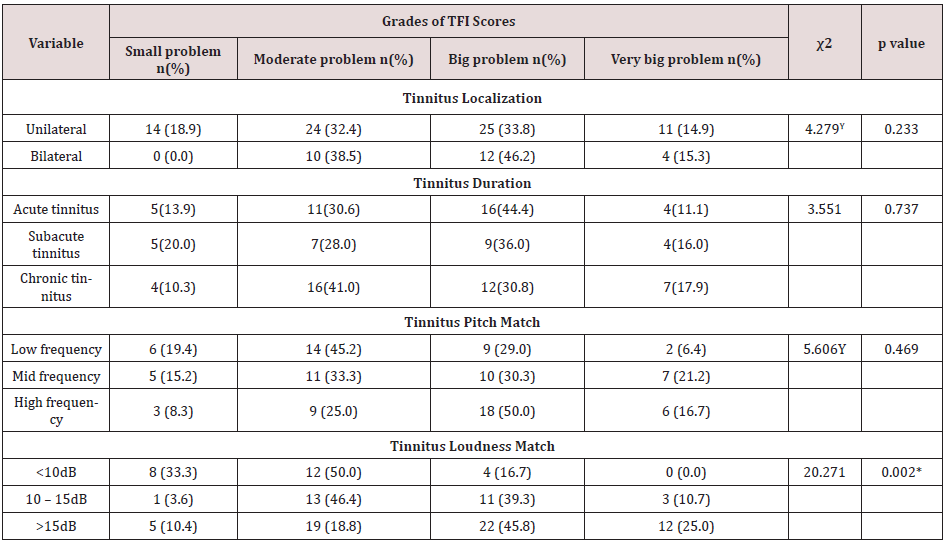
χ2: Chi square test; Y: Yates corrected chi square; *: p value <0.05 (i.e., statistically significant).
Table 4: Correlation of tinnitus duration, PTAv, TPM and TLM with TFI scores.

r: Spearman correlation coefficient; *: p value <0.05 (i.e., statistically significant).
Figure 1(A): Mean air conduction thresholds for the right sided tinnitus ears, left sided tinnitus ears and non-tinnitus ears.
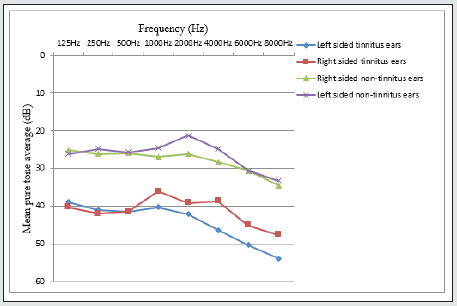
Figure 2: PET / CT fusion images showing multiple confluent lymph node enlargements in the left cervical, bilateral supraclavicular and mediastinal regions in the axial (left), sagittal (center) and coronal (right) sections.
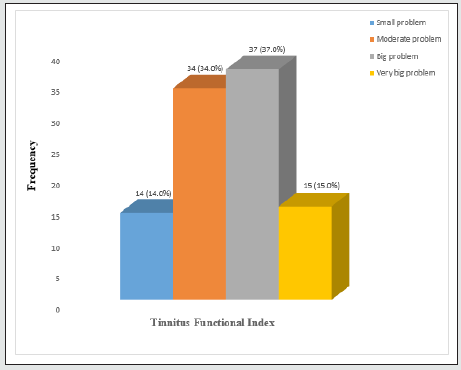
Discussion
The mean age of 51.7 years with highest frequency found in the
age group of 65 - 74 years were similar to the findings of Fackrell et al.
average age of 53.6 years with a range of 18-84 years [30]. Okhakhu
et al. [31] also reported an age range of 18 to 80 years and mean
age of 46.8 years while Bhatt et al32 revealed a mean age of 53.1
years. In consonance with this study, Martines et al. [23] reported
that patients with tinnitus were more frequently between the age of
51 and 70 years with an average age of 58.1 years. In the work done
by Sogebi et al. [12] among elderly tinnitus patients, they revealed
that a higher number of the subjects were between 60 and 69 years
of age. Majority of patients with tinnitus in our study were females.
This is in consonance with findings in previous studies [11,24,31-
35]; however, some other studies3,30,36 revealed a higher number
of male subjects with tinnitus. Despite the inconsistent data on the
effect of gender on characteristics of tinnitus and its distress, females
are more likely to perceive annoyance of tinnitus earlier than their
male counterparts irrespective of age at presentation. It has also
been found that the psychosomatic complaints that are related to
tinnitus symptoms are likely to be more persistent among females
than the male gender [35]. A high number of subjects in this study
presented with chronic tinnitus at the time of first presentation to
the clinic. This report has similarity with the study done by Sogebi
[14] on the characteristics of tinnitus and other previous studies
where a greater number of subjects has been having tinnitus for
more than 2 years [30,32,34]. Most of our tinnitus patients might
have taken their symptom with levity until it causes some form of
irritation or become associated with other symptoms [36]. And
sometimes, they only visit the hospital when it has developed into
a chronic condition [37].
The average duration of tinnitus in our study population was
17.9 months. Ukaegbe et al. [38] in their study of the effect of
tinnitus on the audiometric threshold of tinnitus patients, found a
similar average tinnitus duration of 17.3 months. Although, a high
average tinnitus duration of 35.2 months was reported by Kim et
al. [39] A higher number of subjects experienced worse tinnitus
sensations at night. This was also in line with previous research
works where most of the tinnitus experienced by patients was
more at night [3,32]. It is justifiable that during the day, the effect
of ambient noise may mask the sensation of tinnitus symptoms.
However, some tinnitus patients still continually experience tinnitus
disturbance despite other sources of noise in the environment. The
predominance of tinnitus in the left ear is by chance. No reason was
found for the predominant tinnitus ear in previous studies [3,9,11].
Our study reported a steady rise in the number of subjects from
low frequency to high frequency in TPM as well as the loudness
increases above the hearing thresholds in the TLM of subjects. This
appeared different from the findings of Martines et al. [23] where
there was a gradual reduction in the number of tinnitus patients as
the loudness increases. TLM above the hearing level ranges from
4 - 60dB with an average of about 18dB may suggest that most
of the patients presented to ENT clinic when their symptom was
already causing some levels of distress and affecting their QoL.15
The average tinnitus loudness reported in our study was within the
bracket of what was found in previous studies done in Nigeria and
beyond [33,39-41]. High TFI scores indicate greater adverse effects
on the QoL of tinnitus patients. In our study, tinnitus constituted
one level of health problem or the other in all subjects resulting
into their presentations to ENT clinic. More of the subjects in this
study described their tinnitus as big. This was closely followed by
those who described it as moderate. In a multi centered hospitalbased
study and a questionnaire-based study by Okhakhu et al.
[31] and Prabhu [42] respectively; it was found that the degree
of tinnitus distress was scored as moderate in many of tinnitus
patients. This further corroborated the report that most patients
seek for specialist care when the symptom has already caused some
form of disturbance or became associated with other ear symptoms
[23]. It was however found that in some community studies, greater
than 70% of subjects had little or no tinnitus impact on their QoL
[32,43].
The association between TFI scores and tinnitus localization
was inconsequential. This confirmed the fact that the influence
tinnitus impact had on QoL of patient is not a measure of whether it
is unilateral or bilateral tinnitus, but it is an intrinsic individualized
characteristic. There was a significant positive correlation between
TFI grading and pure tone average as well as the tinnitus loudness
match above hearing thresholds of the subjects. The findings of
Dziendzie et al. [26] also showed a positive correlation between
TFI scores and the mean air conduction levels. The significant
association of TFI score with TLM reported in our study may submit
that a rise in tinnitus loudness might result into a worsened effect
on the QoL of tinnitus patient. The tinnitus loudness is therefore
an important variable that can explain individual differences
with tinnitus distress [44]. Okhakhu et al. [31] and Probst et al.
[45] also reported similar findings. They noticed that there was a
significant effect of loudness of tinnitus on the impact of tinnitus
on QoL. In a work done on the correlation between hearing level,
TPM and loudness with QoL of patients with tinnitus, Savitri E et
al. [44] found a significant positive correlation between loudness
and its impact on QoL. They strongly suggested the need for
psychoacoustic measurement of tinnitus to become a routine
assessment for tinnitus patients [44]. Martines et al. [23] and Fuller
et al. [46] however found no significant correlation between the
psychoacoustic measurements (and hearing levels) and their effect
of tinnitus on QoL. Rabau et al. [47] also affirmed that the loudness
of tinnitus is not always the same as tinnitus impact. In fact, in the
study done on TLM in relation to annoyance and grading of tinnitus
distress, Hiller et al. [48] reported a low tinnitus annoyance despite
high tinnitus loudness.
They therefore proposed that tinnitus loudness and annoyance
are not necessarily harmonious and should be assessed differently
[48]. It is noteworthy that most of these research works were
based on the use of the tinnitus handicap inventory (THI), tinnitus
questionnaire (TQ) and visual analog scale (VAS) in the measurement and assessment of tinnitus effect on QoL. Although, there is presently
no objective means of measuring tinnitus impact; researchers and
specialists can only depend on tinnitus self-reported measures.
More studies where TFI will be used for measurement of tinnitus
influence on QoL and correlated with psychoacoustics measures
are therefore needed in West African sub region to establish the
strength of the association between tinnitus annoyance and tinnitus
psychoacoustic match. Although, the advantage of both the tinnitus
psychoacoustic match procedures and the measurement of QoL in
the comprehensive management and monitoring of treatment of a
tinnitus patient cannot be over emphasized; high frequency TPM
(and sometimes the magnitude of TLM above the hearing level)
does not necessarily imply a worse effect on QoL. This concurs with
the belief that a patient’s response to the effect of tinnitus cannot be
categorised into a simple function of its psychoacoustic measures
but rather as a complex interconnection between acoustic
phantom symptoms, psychological/somatic factors and depressive
symptoms [48,49]. This might explain why some patients are
disabled by the effect of tinnitus while others could cope with it
comfortably [49]. In conclusion, more of the patients in our study
described their experience of tinnitus as a big problem. The PTAv
and TLM have been positively correlated with the health related
QoL measurement. It was therefore recommended and advocated
to measure the tinnitus intensity and distress routinely with TFI
and tinnitus matching procedures. However, the implementation of
all-inclusive management of tinnitus should be highly personalized.
In addition, more studies are needed to be carried out on a larger
sampled population for evaluation of the socioeconomic impact of
tinnitus on Africans.
References
- Ogah SA, Lasebikan T (2017) Prevalence of Tinnitus in Lokoja, North Central Nigeria: A 5-year Retrospective Study. SMU Med J 4(1): 66-71.
- Nondahl DM, Cruickshanks KJ, Wiley TL, Klein R, Klein BE, et al. (2002) Prevalence and 5-Year Incidence of Tinnitus among Older Adults: The Epidemiology of Hearing Loss Study. J Am Acad Audiol 13(6): 323-331.
- Adegbenro CA, Amusa YB, Ijadunola IKT, Adeyemo A (2013) Prevalence of Tinnitus among Nigerians. J Community Med Heal Educ 3(2): 1-4.
- Ceranic B, Luxon LM (2008) Tinnitus and other dysacuses. Gleeson M (Eds.), Scott-Brown’s Otorhinolaryngology Head and Neck Surgery, 7th Ed, Arnold Hodder, London, UK pp. 3594-3619.
- Lockwood AH, Salvi RJ, Burkard RF (2002) Tinnitus. N Engl J Med 347(12): 904-910.
- Shargorodsky J, Curhan GC, Farwell WR (2010) Prevalence and characteristics of tinnitus among US adults. Am J Med 123(8): 711-718.
- Sunny OD, Asoegwu CN, Abayomi SO (2012) Subjective tinnitus and its association with use of earphones among students at the college of medicine, University of Lagos, Nigeria. Int Tinnitus J 17(2): 169-172.
- Stephens SDG (1984) The treatment of tinnitus a historical perspective. J Laryngol Otol 98: 963-972.
- Lasisi AO, Abiona T, Gureje O (2010) Tinnitus in the elderly: Profile, correlates, and impact in the Nigerian study of ageing. Otolaryngol - Head Neck Surg 143(4): 510-515.
- Falkenberg ES, Wie OB (2012) Anxiety and Depression in Tinnitus Patients: 5-Year Follow-Up Assessment after Completion of Habituation Therapy. Int J Otolaryngol 2012: 1-7.
- Gibrin PCD, Melo JJ, Marchiori LLM (2013) Prevalence of tinnitus complaints and probable association with hearing loss, diabetes mellitus and hypertension in elderly. CoDAS 25(2): 176-180.
- Sogebi OA, Amoran OE, Oyewole EA (2016) Prevalence and Correlates for Tinnitus among Elderly Subjects: A Community Study. Br J Med Med Res 15(2): 1-9.
- Ologe FE, Segun-Busari S, Abdulraheem IS, Afolabi AO (2005) Ear Diseases in Elderly Hospital Patients in Nigeria. J Gerontol Med Sci 60A(3): 404-406.
- Sogebi OA (2013) Characterization of tinnitus in Nigeria. Auris Nasus Larynx 40(4): 356-360.
- Martines F, Bentivegna D, Martines E, Sciacca V, Martinciglio G (2010) Assessing audiological, pathophysiological and psychological variables in tinnitus patients with or without hearing loss. Eur Arch Oto-Rhino-Laryngology 267: 1685-1693.
- Bauer CA (2015) Tinnitus and Hyperacusis. In: Flint PW, editor. Cummings Otolaryngology Head and Neck Surgery, 6th Ed, Elsevier Inc, Philadelphia pp. 2336-2343.
- Kay A (2008) Tinnitus : A Common and Manageable Complaint. Community ear Hear Heal 5(8): 17-32.
- Deshaies P, Gonzales Z, Zenner HP, Plontke S, Paré L, et al. (2005) Quantification of the burden of disease for tinnitus caused by community noise. WHO: Quantifying disease from environmental noise? Bern, Switzerland.
- Tunkel DE, Bauer CA, Sun GH, Rosenfeld RM, Chandrasekhar SS, et al. (2014) Clinical Practice Guideline : Tinnitus. Am J Otolaryngol - Head Neck Surg 151(2S): S1-40.
- Cima RFF, Mazurek B, Haider H, Kikidis D, Lapira A, et al. (2019) A multidisciplinary European guideline for tinnitus: diagnostics, assessment, and treatment. HNO 67(Suppl 1): S10-42.
- Stephens D, Hetu R (1991) Impairment, Disability and Handicap in Audiology. Audiology 30: 185-200.
- Osisanya A, Abiola O (2013) Psychosocial effects of tinnitus on the elderly individuals with normal hearing abilities in Ibadan, Oyo state Nigeria. African J Psychol Study Soc Issues 16(1): 114.
- Martines F, Sireci F, Cannizzaro E, Costanzo R, Martines E, et al. (2015) Clinical observations and risk factors for tinnitus in a Sicilian cohort. Eur Arch Oto-Rhino-Laryngology 272(10): 2719-2729.
- Adoga AA, Kokong DD, Nimkur TL, Okwori ET (2015) The impact of tinnitus on adult Nigerians: health related Quality of Life assessment of sufferers using the Hospital Anxiety and Depression Scale (HADS) and the RAND-36 item health survey 1.0 questionnaire. Int Tinnitus J 19(2): 26-32.
- Meikle M, Henry J, Griest S, Stewart B, Abrams H, et al. (2012) The tinnitus functional index: development of a new clinical measure for chronic, intrusive tinnitus. Ear Hear 33(2): 153-176.
- Dziendziel B, Skarżyński PH, Rajchel JJ, Gos E, Skarżyński H (2019) Prevalence and severity of tinnitus in Polish otosclerosis patients qualified for stapes surgery. Eur Arch Oto-Rhino-Laryngology 276(6): 1585-1590.
- BSA (2011) Pure tone air and bone conduction threshold audiometry with and without masking and determination of uncomfortable loudness levels. British Society of Audiology p. 1-13.
- WHO (2007) World Health Organization. Prevention of Blindness and deafness: Grades of Hearing Impairment.
- Arlinger S (2008) Psychoacoustic audiometry. Gleeson M (Eds.), Scott-Brown’s Otorhinolaryngology, Head and Neck Surgery, 7th Ed, Arnold Hodder, London, UK p. 3260-3266.
- Fackrell K, Hall DA, Barry JG, Hoare DJ (2017) Performance of the Tinnitus Functional Index as a diagnostic instrument in a UK clinical population. Hear Res 55(17): 1-12.
- Okhakhu AL, Afolabi OA (2015) Patients’ Perception of a Symptomatic Tinnitus among Nigerians: A multi-institutional study. Sierra Leone J Biomed Res 7(2): 28-33.
- Bhatt JM, Lin HW, Bhattacharyya N (2016) Prevalence, Severity, Exposures, and Treatment Patterns of Tinnitus in the United States. JAMA Otolaryngol - Head Neck Surg 142(10): 959-965.
- Olusesi AD, Adedoja OA (2013) Characterisitics and maskability of self-reported tinnitus in Adult Nigerians. Int Tinnitus J18(2): 182-186.
- Goyal D, Gupta N (2015) Study of correlation of tinnitus and sensorineural hearing loss. J Adv Med Dent Scie Res 3(2): 11-15.
- Marmut Z, Belojevic G, Backovic D, Zivojinovic JI, Tomanic M, et al. (2014) Tinnitus among Serbian secondary school students in relation to their behavior and habits. Noise Heal 16: 73-78.
- Ding X, Zhang X, Huang Z, Feng X (2018) The Characteristic and Short-Term Prognosis of Tinnitus Associated with Sudden Sensorineural Hearing Loss 2018: 1-7.
- Dong SH, Kim SS, Yeo JH, Kim HJ, Kim SH, et al. (2017) Clinical and Audiologic Characteristics of Tinnitus in Subjects Aged < 65 and ≥ 65 Years. J Int Adv Otol 13: 349-353.
- Ukaegbe O, Ezeanolue B, Orji F (2016) The Influence of Tinnitus on the Audiometric Threshold of Sufferers. Int Arch Otorhinolaryngol 20: 339-343.
- Kim TS, Yakunina N, Ryu YJ, Chung IJ, Nam EC (2017) Self-Administered Tinnitus Pitch Matching versus a Conventional Audiometric Procedure. Audiol Neurotol 22(1): 1-8.
- Flores L, Teixeira A, Rosito L, Seimetz B, Dall’Igna C (2015) Pitch and loudness from tinnitus in individuals with noise-induced hearing loss. Int Arch Otorhinolaryngol 20(03): 248-253.
- Morais AA, Gil D (2012) Tinnitus in individuals without hearing loss and its relationship with temporomandibular dysfunction. Braz J Otorhinolaryngol 78(2): 59-65.
- Prabhu P (2019) Is tinnitus a major concern in individuals with auditory neuropathy spectrum disorder ? Questionnaire based study. World J Otorhinolaryngol Neck Surg 5(1): 1-5.
- Kim HJ, Lee HJ, An SY, Sim S, Park B, et al. (2015) Analysis of the Prevalence and Associated Risk Factors of Tinnitus in Adults. PLoS One10(5): 1-15.
- Savitri E, Qadarpunagi A, Sabruddin (2014) Correlation between Hearing Threshold, Tinnitus Pitch and Loudness with Quality of Life of Tinnitus Patients in Makassar. Int J Heal Sci Res 4(11): 32-39.
- Probst T, Pryss R, Langguth B, Schlee W (2016) Emotional states as mediators between tinnitus loudness and tinnitus distress in daily life: Results from the “Track Your Tinnitus” application. Sci Rep 6(20382): 1-8.
- Fuller T, Cima R, Langguth B, Mazurek B, Waddell A, et al. (2017) Cognitive behavioural therapy for tinnitus ( Protocol ). Cochrane Database Syst Rev 12(4): 1-18.
- Rabau S, Wouters K, Van de Heyning P (2014) Validation and translation of the Dutch Tinnitus Functional Index. B-ENT 10(4): 251-258.
- Hiller W, Goebel G (2007) When tinnitus loudness and annoyance are discrepant: audiological characteristics and psychological profile. Audiol Neurootol 12(6): 391-400.
- Dobie RA (2003) Depression and tinnitus. Otolaryngol Clin North Am 36: 383-388.

Top Editors
-

Mark E Smith
Bio chemistry
University of Texas Medical Branch, USA -

Lawrence A Presley
Department of Criminal Justice
Liberty University, USA -

Thomas W Miller
Department of Psychiatry
University of Kentucky, USA -

Gjumrakch Aliev
Department of Medicine
Gally International Biomedical Research & Consulting LLC, USA -

Christopher Bryant
Department of Urbanisation and Agricultural
Montreal university, USA -

Robert William Frare
Oral & Maxillofacial Pathology
New York University, USA -

Rudolph Modesto Navari
Gastroenterology and Hepatology
University of Alabama, UK -

Andrew Hague
Department of Medicine
Universities of Bradford, UK -

George Gregory Buttigieg
Maltese College of Obstetrics and Gynaecology, Europe -

Chen-Hsiung Yeh
Oncology
Circulogene Theranostics, England -
.png)
Emilio Bucio-Carrillo
Radiation Chemistry
National University of Mexico, USA -
.jpg)
Casey J Grenier
Analytical Chemistry
Wentworth Institute of Technology, USA -
Hany Atalah
Minimally Invasive Surgery
Mercer University school of Medicine, USA -

Abu-Hussein Muhamad
Pediatric Dentistry
University of Athens , Greece

The annual scholar awards from Lupine Publishers honor a selected number Read More...




